Ear Training Appendix
Examples for Sight-counting and Sight-singing: Level 2
Chelsey Hamm and Levi Langolf
Key Takeaways
- No new beat units, time signatures, or beat divisions are introduced in this chapter.
- This chapter includes dotted rhythmic values that have a duration smaller than a full measure. (To review this topic see Notating Rhythm.)
- A tie is a curved line that connects two or more notes with the same pitch. Tied-to notes are not rearticulated.
- Dynamics and articulations are covered in this chapter. (To review this topic see Other Aspects of Notation.)
- Melodies within this chapter include leaps of thirds, fourths, fifths, and octaves within the tonic triad.
- This chapter includes two-part rhythms and two-part melodies.
This chapter builds upon the prior gradated rhythms and melodies. Previously studied meters and key signatures are included. Knowledge of dynamics, articulations, and phrase markings is assumed from the beginning of this chapter. All exercises are author-composed.
Section 4
The following eight exercises include dotted rhythmic values that do not have the duration of a full measure. Dynamic markings as well as crescendos and decrescendos are now included.
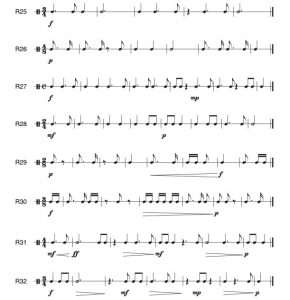
The following two exercises include dotted rhythmic values that do not have the duration of a full measure.

The following four exercises are melodies in the major mode that include leaps of thirds and fourths within the tonic triad.
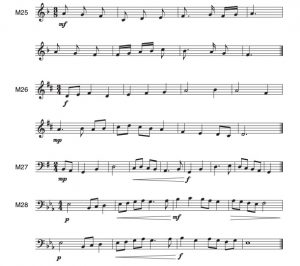
The following four exercises are melodies in the minor mode that include leaps of thirds and fourths within the tonic triad.
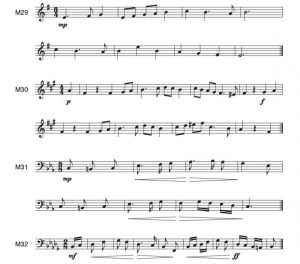
The following two exercises are two-part melodies that include leaps of thirds and fourths within the tonic triad.
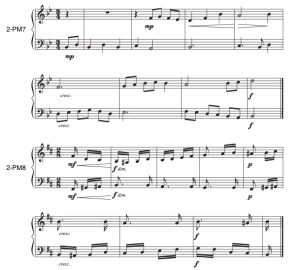
Section 5
The following eight exercises are rhythms that include ties that are within measures. Articulations are now included.
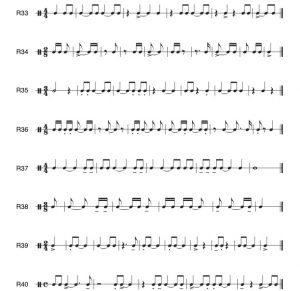
The following two exercises are two-part rhythms that include ties that are within measures.

The following four exercises are melodies in the major mode that include more frequent leaps of thirds and fourths within the tonic triad.
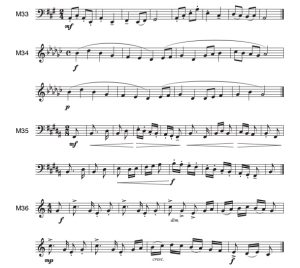
The following four exercises are melodies in the minor mode that include more frequent leaps of thirds and fourths within the tonic triad.
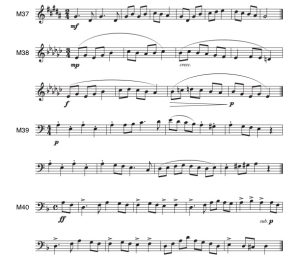
The following two exercises are two-part melodies that include more frequent leaps of thirds and fourths within the tonic triad.
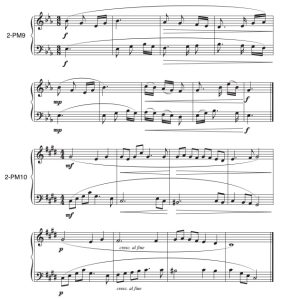
Section 6
The following eight exercises are rhythms that include ties that extend across bar lines.
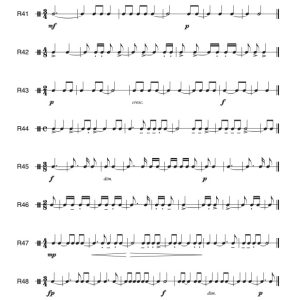
The following two exercises are two-part rhythms that include ties that extend across bar lines.
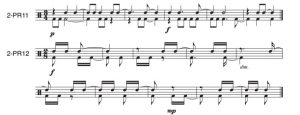
The following four exercises are melodies in the major mode that include larger leaps of fifths and octaves within the tonic triad.
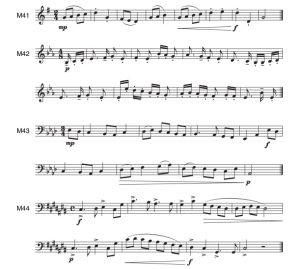
The following four exercises are melodies in the minor mode that include larger leaps of fifths and octaves within the tonic triad.
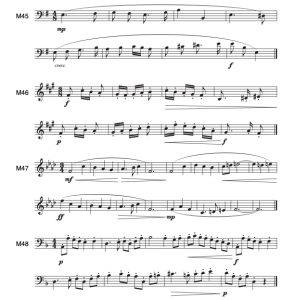
The following two exercises are two-part melodies that include larger leaps of fifths and octaves within the tonic triad.
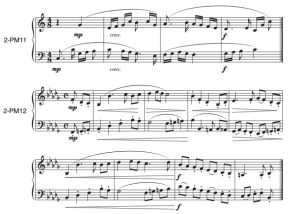
- Chenette, Timothy. 2022, “Aural Skills Pedagogy Research.” Foundations of Aural Skills. Pressbooks: https://uen.pressbooks.pub/auralskills/back-matter/aural-skills-pedagogy-research/.
- ——. 2021. “What are the Truly Aural Skills?” Music Theory Online 27, no. 2: https://mtosmt.org/issues/mto.21.27.2/mto.21.27.2.chenette.html.
- Chenette, Timothy, Stacey Davis, and Stanley Kleppinger. 2022. “A Critical Review of Current Aural Skill Materials and Pedagogical Practices.” Journal of Music Theory Pedagogy 36, 6: https://digitalcollections.lipscomb.edu/jmtp/vol36/iss1/6.
- Cleland, Kent and Paul Fleet. 2021. The Routledge Companion to Aural Skills Pedagogy. New York: Routledge.
- Floyd, Eva G. and Marshall A. Haning. 2014. “Sight-Singing Pedagogy: A Context Analysis of Choral Methods Textbooks.” Journal of Music Teacher Education 25, no. 1: 11–22.
- Karpinski, Gary. 2021. Manual for Ear Training and Sight Singing. New York: Norton.
- ——. 2000. Aural Skills Acquisition. New York: Oxford.
- Kleppinger, Stanley. 2017. “Practical and Philosophical Reflections Regarding Aural Skills Assessment.” Indiana Theory Review 33, nos. 1–2: 153–182.
- Rogers, Nancy and Robert W. Ottman. 2021. Music for Sight Singing. London: Pearson.
- Urist, Diane J. 2016. The Moving Body in the Aural Skills Classroom: a Eurhythmics Based Approach. New York: Oxford.
- Melodies for Sight Singing (teoria)
- Melodies for Sight Singing (Chorale Tech)
- Melodies for Sight Singing (Ronnie Sanders)
- Rhythms for Sight Counting (Blue Sky Music)
- Sight Singing by Level (YouTube)
- Multimodal Musicianship: Rhythms, Melodies, Rhythmic/Melodic/Harmonic Dictations (Victoria Malawey)
- Foundations of Aural Skills (Timothy Chenette)
Media Attributions
- Section 4 Rhythms © Levi Langolf is licensed under a CC BY-SA (Attribution ShareAlike) license
- Section 4 Two-part Rhythms © Levi Langolf is licensed under a CC BY-SA (Attribution ShareAlike) license
- Section 4 Major Melodies © Levi Langolf is licensed under a CC BY-SA (Attribution ShareAlike) license
- Section 4 Minor Melodies © Levi Langolf is licensed under a CC BY-SA (Attribution ShareAlike) license
- Section 4 Two-part Melodies © Levi Langolf is licensed under a CC BY-SA (Attribution ShareAlike) license
- Section 5 Rhythms © Levi Langolf is licensed under a CC BY-SA (Attribution ShareAlike) license
- Section 5 Two-part Rhythms © Levi Langolf is licensed under a CC BY-SA (Attribution ShareAlike) license
- Section 5 Major Melodies © Levi Langolf is licensed under a CC BY-SA (Attribution ShareAlike) license
- Section 5 Minor Melodies © Levi Langolf is licensed under a CC BY-SA (Attribution ShareAlike) license
- Section 5 Two-part Melodies © Levi Langolf is licensed under a CC BY-SA (Attribution ShareAlike) license
- Section 6 Rhythms © Levi Langolf is licensed under a CC BY-SA (Attribution ShareAlike) license
- Section 6 Two-part Rhythms © Levi Langolf is licensed under a CC BY-SA (Attribution ShareAlike) license
- Section 6 Major Melodies © Levi Langolf is licensed under a CC BY-SA (Attribution ShareAlike) license
- Section 6 Minor Melodies © Levi Langolf is licensed under a CC BY-SA (Attribution ShareAlike) license
- Section 6 Two-part Melodies © Levi Langolf is licensed under a CC BY-SA (Attribution ShareAlike) license
Connects two or more notes of the same pitch; notes after the initial one are not rearticulated.

